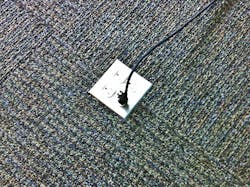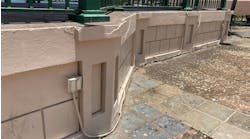How well do you know the Code? Think you can spot violations the original installer either ignored or couldn't identify? Here's your chance to moonlight as an electrical inspector and second-guess someone else's work from the safety of your living room or office. It's your turn to identify the violation.
Hint: Floor plug folly
Find the Answer
For receptacles installed in floors, Sec. 314.27(B) requires boxes to be specifically listed for this application. By the looks of this installation, the installer used a couple of “old work” style boxes with a stainless steel receptacle cover. This type of installation would be appropriate for wall applications, but not for floor applications. The Exception to this Code rule would permit the AHJ to approve other types of boxes where the receptacle was located in elevated floors of show windows, but this receptacle was installed in the middle of an office. Therefore, this Exception would not be applicable in this case.
Sections 406.5(E) and (D) have requirements for receptacles that are installed “face-up” in countertops, work surfaces, seating areas, and similar locations. These sections each require assemblies that are specifically listed for that application. Those types of assemblies are equipped with bodies, and covers that provide much better protection from falling debris and liquids that could easily end up inside the receptacle.
The bottom line is general purpose type boxes and covers are not appropriate for installation in floors.





